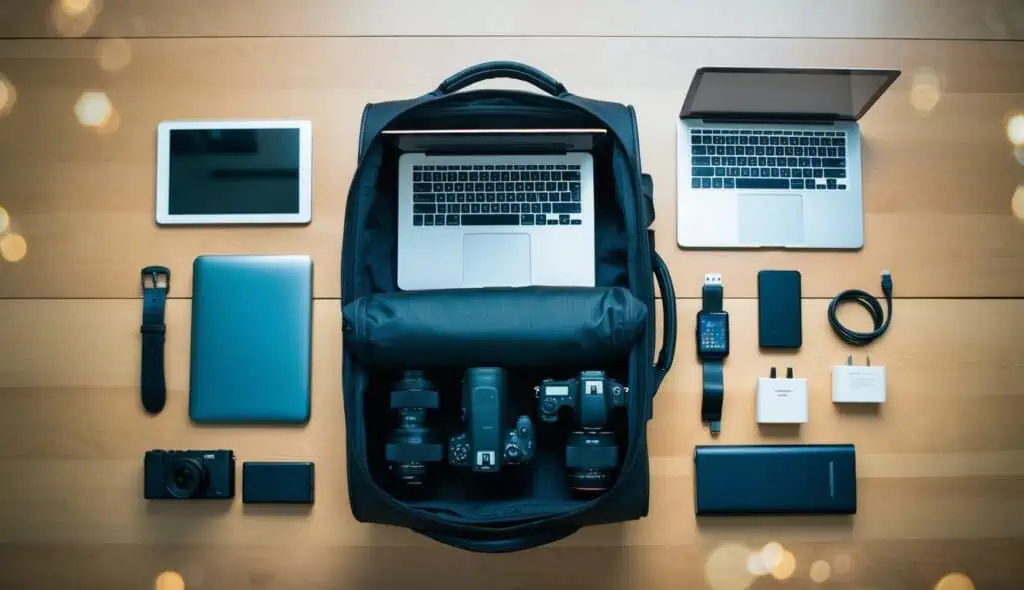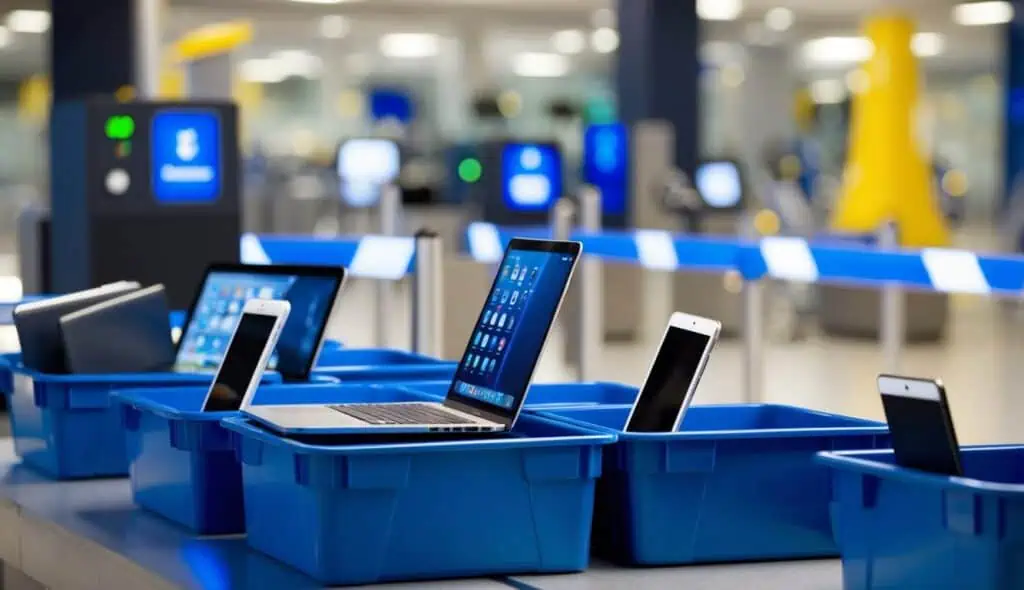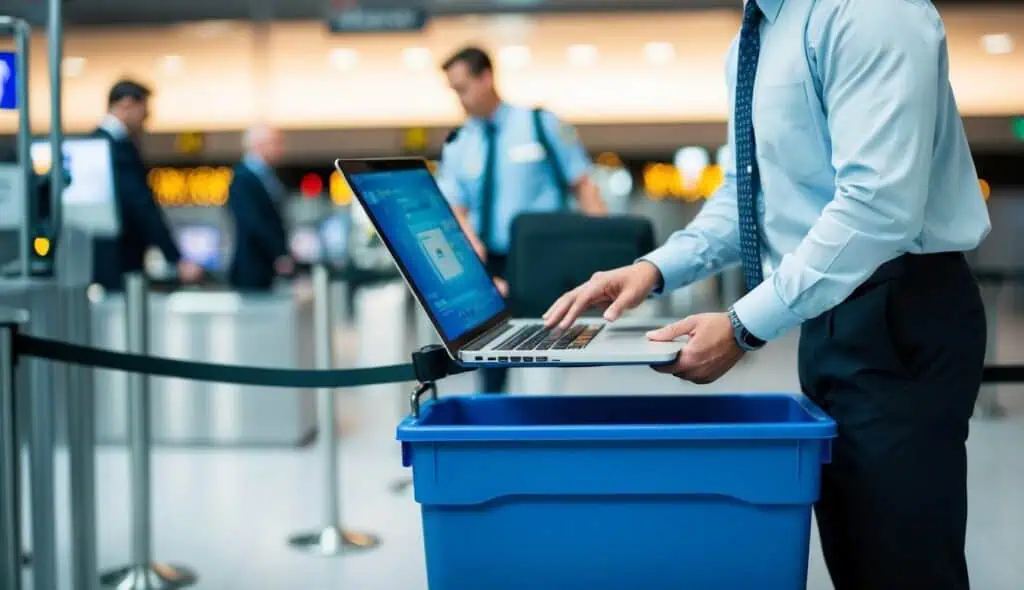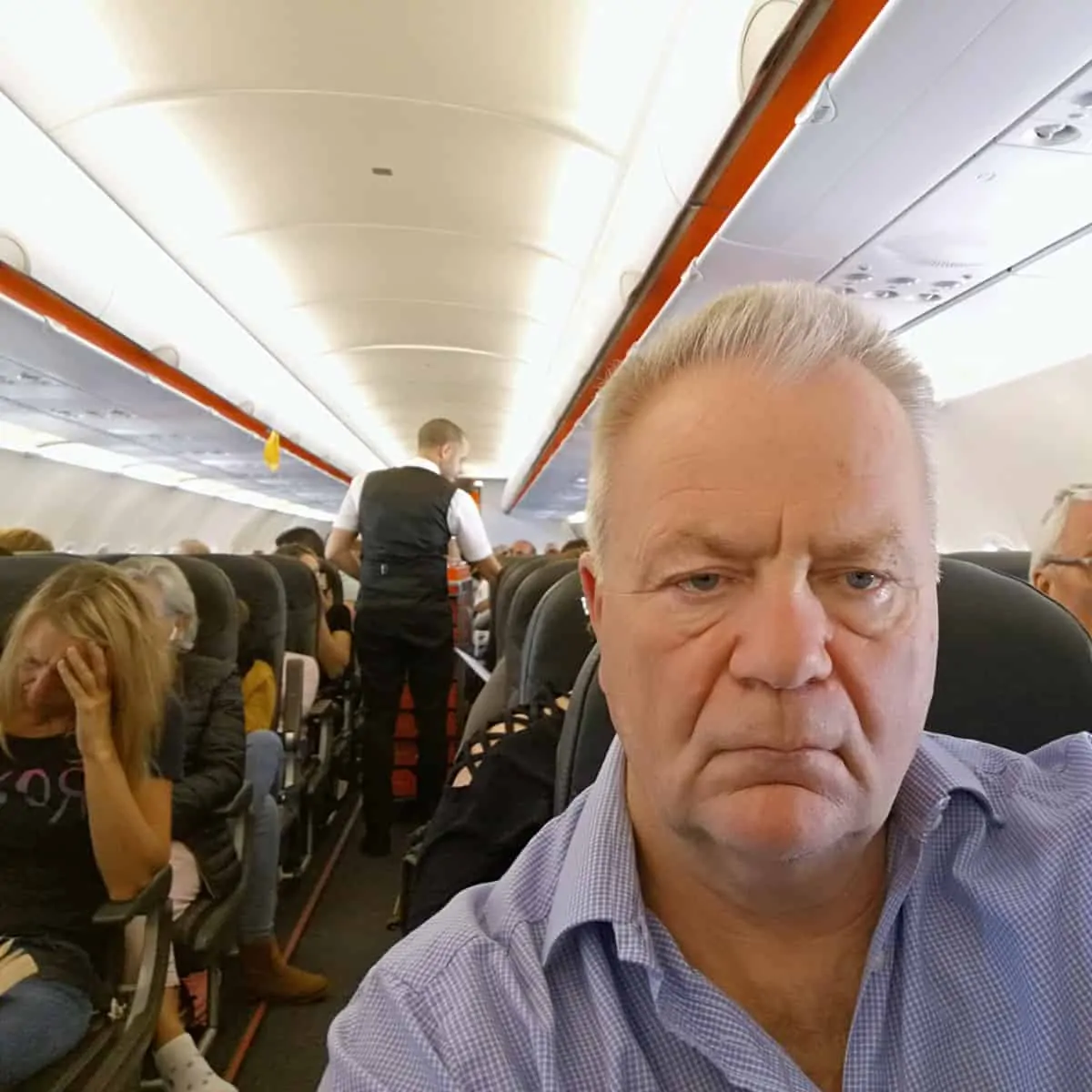Packing for a flight can be stressful, especially when it comes to electronics. You want to make sure you have all your gadgets with you, but you also need to follow airline rules.
Knowing what’s allowed in your carry-on bag can save you time and hassle at security.

Most common electronics like laptops, phones, tablets, and cameras are allowed in carry-on bags. You can also bring chargers, headphones, and portable power banks. These items usually need to be taken out of your bag and placed in a bin for screening.
I have carried laptops, tablets, phones, digital cameras and many other types of electronic devices on flights all over the world without a problem, provided I follow the rules.
Some electronics have special rules. Lithium batteries must be in a device or carried on, not checked.
Large electronics may need extra screening. It’s best to check with your airline if you’re unsure about a specific item.
Keeping up with the latest rules helps ensure a smooth trip through airport security.
Contents
Transportation Security Administration (TSA) Guidelines

The TSA has specific rules for carrying electronics and liquids in your carry-on bags. These guidelines help keep air travel safe and efficient. Let’s look at the key rules you need to know.
3-1-1 Liquids Rule
The 3-1-1 rule applies to liquids in your carry-on:
- 3.4 ounces (100 milliliters) or less per container
- 1 quart-sized, clear plastic, zip-top bag
- 1 bag per passenger
Put your liquids bag in the bin for X-ray screening. This includes items like shampoo, toothpaste, and lotions.
Medications and baby formula are exempt from this rule. Tell the TSA officer about these items before screening.
Electronic Devices Screening
You can bring most electronics in your carry-on bag. This includes:
- Laptops
- Tablets
- E-readers
- Cameras
- Cell phones
Remove large electronics from your bag for X-ray screening. Place them in a bin with nothing on top or below.
Charge your devices before travel. TSA may ask you to turn them on to prove they work.
Battery-Powered Restrictions
You can pack most batteries in carry-on bags. This includes:
- Dry cell alkaline batteries (AA, AAA, C, D)
- Rechargeable batteries (NiMH, NiCad)
- Lithium-ion batteries (under 100 watt-hours)
Spare lithium batteries must be in carry-on bags only. Pack them to prevent short circuits.
Don’t pack damaged or recalled batteries. Check with your airline for specific rules on battery types and sizes.
Laptops and Larger Electronics

Laptops and other big electronics need special handling at airport security. You must follow certain rules to bring these items on planes.
Removal from Bags
Take laptops out of your carry-on when going through security. Place them in a separate bin for x-ray screening. This rule applies to tablets and other large electronics too. The TSA needs a clear view of these devices.
If you have TSA PreCheck, you can keep laptops in your bag. This makes the screening process faster. But be ready to remove them if asked.
Special Instructions for MacBooks
Some MacBook Pro models need extra care. In 2019, the FAA banned certain 15-inch MacBook Pros made between 2015-2017. These laptops had faulty batteries that could overheat.
Check if your MacBook Pro is affected. Apple’s website has a tool to see if your model is banned. If it is, you can’t bring it on planes unless Apple fixed the battery. Bring proof of the repair if you had it done.
For all other MacBooks, follow standard laptop rules. Remove them from your bag at security unless you have TSA PreCheck.
Smartphones and Tablets
Smartphones and tablets are essential travel companions for many flyers. These devices are allowed in carry-on bags and can be used during most of your flight. Knowing how to prepare and use them properly will make your journey smoother.
Charging Before Flight
Make sure your devices are fully charged before boarding. This helps avoid battery drain during security checks. You can also bring portable chargers or power banks in your carry-on. Keep in mind that these must be under 100 watt-hours.
Pack your charging cables in an easy-to-reach spot. Some planes have USB ports or outlets at seats. Check your airline’s website to see if your flight offers this perk.
Remember to turn off cellular data when flying. This prevents excessive battery drain from your device searching for a signal.
Use During Takeoff and Landing
You can keep your phone or tablet with you during takeoff and landing. But you must follow crew instructions about when to use them.
Most airlines require devices to be in airplane mode from gate to gate. This means turning off cellular data, Wi-Fi, and Bluetooth.
During critical flight phases, you may need to stow larger tablets. Smaller devices like phones can usually stay in your pocket.
Once at cruising altitude, you’re often free to use your devices. Many planes now offer in-flight Wi-Fi for a fee. Check if this service is available on your flight.
Personal Items with Integrated Batteries
Many gadgets you use daily have built-in batteries. Airlines have rules about what you can bring on planes. It’s key to know which items are okay and which aren’t.
Smart Luggage
Smart bags have built-in tech like GPS, USB ports, and motors. Some are okay to bring, but others aren’t. You can pack smart bags with removable batteries in carry-on or checked bags. Take out the battery before you check the bag.
Bags with non-removable batteries are trickier. You can’t check these at all. For carry-on, the battery must be under 100 watt-hours. If it’s between 100-160 watt-hours, you need airline approval.
Always check your airline’s rules. They might be stricter than general guidelines.
Wearable Electronics
Smartwatches, fitness trackers, and other wearables are fine in carry-on and checked bags. These devices have small batteries that don’t pose risks.
You can wear these items through security. No need to take them off like larger electronics.
Pack any spare batteries for these devices in your carry-on bag. Don’t put extra batteries in checked luggage.
Remember to turn off or put devices in airplane mode during the flight. This helps save battery and follows airline rules.
Medical Devices
Medical devices are essential for many travelers. You can bring them in your carry-on bag. The TSA has special rules to make sure you can travel safely with your devices.
Pre-Flight Approval
Contact your airline before your trip. Let them know about your medical device. This helps avoid issues at the airport. Some airlines may need extra info or forms. Do this at least 48 hours before your flight.
Ask if you need a doctor’s note. Some devices might need one. The note should explain why you need the device.
Check if your device needs special screening. The TSA might need to check it separately. This can take extra time, so arrive early.
Packing and Handling Instructions
Pack your device in your carry-on bag. Don’t put it in checked luggage. This keeps it safe and close to you.
Bring extra batteries if your device needs them. Pack them in your carry-on too. Keep them in their original packaging if possible.
Take out your device at security. Put it in a bin for screening. Tell the TSA agent about it. They might need to do extra checks.
Keep medicines with your device if needed. Make sure they’re labeled clearly. Liquid medicines over 3.4 ounces are allowed. Just tell the TSA about them.
Clean your device before and after security. This helps keep it germ-free during travel.
Children’s Electronic Toys
Kids’ electronic toys can be great for keeping little ones entertained during flights. But there are a few rules to follow when packing these items in carry-on bags.
Size and Switch-Off Requirements
Electronic toys need to fit in your carry-on bag and go through the X-ray machine at security. Smaller handheld games and tablets are usually fine. Bigger toys may need to go in checked luggage.
You’ll need to turn off electronic toys during takeoff and landing. This helps avoid interference with the plane’s systems. Pack toys with easily accessible power buttons.
Make sure to charge toys before the flight. Bring extra batteries if needed. Remember that loose batteries must go in carry-on bags, not checked luggage.
Consider headphones for noisy toys. This keeps other passengers happy. Noise-cancelling headphones can also help kids stay calm during the flight.
Prohibited Items
Many items are not allowed in carry-on bags for safety reasons. The TSA bans things that could be dangerous on planes. Let’s look at two key categories of prohibited items.
Explosive and Flammable Items
You can’t bring explosives or flammable items in your carry-on. This includes:
- Fireworks
- Flares
- Gasoline
- Lighter fluid
- Spray paint
- Bleach
The TSA also bans other items that could start fires. These include:
- Matches (except one book of safety matches)
- Torch lighters
- Gel-type candles
You should pack any allowed flammable items carefully in your checked bags. This keeps everyone safe during the flight.
Self-Heating Meals and Beverages
Self-heating food and drinks are not allowed in carry-on or checked bags. These items use chemical reactions to warm up. The TSA bans them because they could be unsafe.
Some examples of prohibited self-heating items are:
- Flameless ration heaters
- Ready-to-eat meals with built-in heaters
- Self-heating coffee or tea
These products often contain chemicals or pressurized contents. They might react badly during a flight. It’s best to leave them at home or buy them after you land.
International Flights
Flying internationally with electronics requires extra preparation. Rules can vary between countries and airlines. Knowing what to expect helps avoid issues at security.
Compliance with Foreign Regulations
Different countries have their own rules about electronics on planes. Check the rules for your destination before packing. Some nations limit the number of devices you can bring. Others may ban certain types of gadgets entirely.
Pack your electronics in carry-on bags when possible. This keeps them safe and accessible. Make sure all devices are charged before your flight. Security may ask you to turn them on.
Bring the right power adapters for your destination. Voltage and plug shapes differ around the world. A universal adapter can be handy for multiple countries.
Extra Screening Procedures
International flights often have stricter security checks. Be ready to remove electronics from your bags. This includes laptops, tablets, and cameras. Place them in separate bins for x-ray screening.
Some airports use advanced scanners. You may not need to take out your devices with these. Follow the instructions of security staff.
Bigger electronics might get extra attention. Drones, gaming consoles, and professional camera gear may need manual inspection. Allow extra time for this process.
Keep your devices organized. Use clear bags or cases. This speeds up screening and protects your gear. Be patient and cooperative with security personnel.
Frequently Asked Questions
Travelers often have questions about bringing electronics on flights. Here are answers to common concerns about devices, screening procedures, and regulations.
Can you list the electronic devices that are permitted in carry-on luggage?
You can bring most common electronic devices in your carry-on bag. These include:
- Laptops
- Tablets
- Smartphones
- E-readers
- Cameras
- Portable gaming systems
What types of electronics must be removed from bags during TSA screenings?
You need to take out larger electronics during screening. This includes:
- Laptops
- Tablets larger than a cell phone
- Gaming consoles
- DVD players
Smaller devices like phones can stay in your bag.
Are there any size or quantity limitations for electronics in hand luggage?
There are no strict limits on how many electronics you can bring. But your bag must fit in the overhead bin or under the seat.
Very large electronics may need to be checked. Ask your airline about size restrictions for carry-ons.
Which electronic items are prohibited in carry-on bags on domestic flights?
You can’t bring these items in your carry-on:
- Hoverboards
- Drones (some airlines allow them)
- Samsung Galaxy Note 7 phones (banned on all flights)
- Electronic cigarettes (allowed but can’t be used or charged on planes)
How does the allowance of electronic items differ for international flights compared to domestic?
Rules for electronics are mostly the same for domestic and international flights. But some countries have extra rules.
For example, the UK bans large electronics in cabins on flights from certain countries. Check your destination’s rules before you fly.
What are the TSA’s regulations on batteries and power banks in carry-on luggage?
You can bring batteries and power banks in carry-on bags. But there are some rules:
- Loose batteries must be protected from short circuits
- Lithium batteries can’t exceed 100 watt hours
- You’re limited to two larger spare batteries (100-160 watt hours)
Power banks are treated like spare batteries. Keep them in your carry-on, not checked bags.

I have been traveling around the world by air since the early 70s and living overseas too. I worked for British Airways for a number of years and I am also a private pilot. About Me


